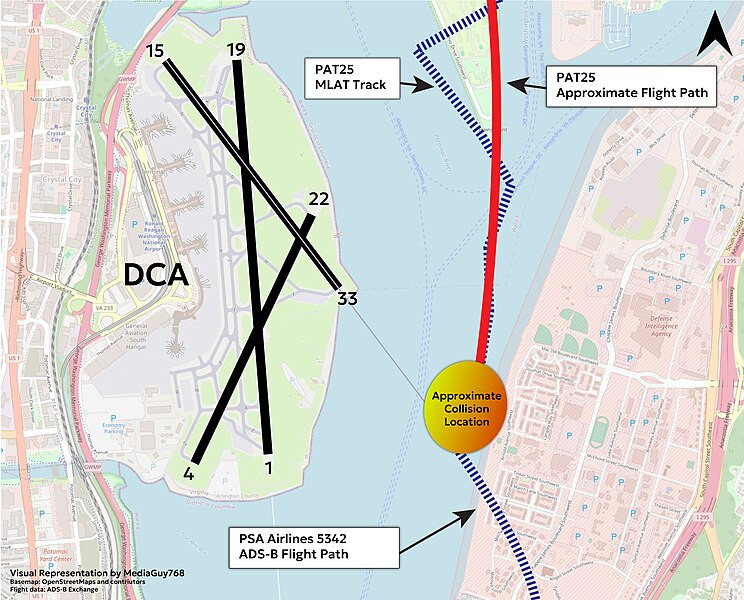A midair collision between an American Airlines regional jet and a U.S. Army Black Hawk helicopter over Washington, D.C., has left no expected survivors, authorities confirmed Thursday morning. The crash, which occurred near Reagan National Airport, sent both aircraft plunging into the icy waters of the Potomac River.
John Donnelly, chief of D.C. Fire and EMS, stated that 27 bodies have been recovered from the wreckage of the plane, along with one from the helicopter. " At this point, we don't believe there are any survivors," Donnelly told reporters. The operation, which began as a rescue effort, has now shifted to a recovery mission. First responders continue to navigate extreme cold, heavy wind, and ice-covered water as they search for additional victims and wreckage.
The collision involved American Eagle Flight 5342, a Bombardier CRJ700 operated by PSA Airlines, carrying 60 passengers and four crew members. The aircraft had departed Wichita, Kansas, and was on its final approach to Reagan National when it collided with a Sikorsky H-60 Black Hawk helicopter conducting a training exercise out of Fort Belvoir, Virginia. The helicopter was carrying three U.S. Army personnel.
The incident, which occurred around 9 p.m. Wednesday, was captured on a live-stream camera from the Kennedy Center. The footage shows an explosion over the Potomac at 8:47 p.m. Investigators from the National Transportation Safety Board (NTSB) and the Federal Aviation Administration (FAA) have launched a formal probe into the crash, marking the first major commercial airline disaster in the United States since 2009.
Emergency crews and dive teams have been working through the night to locate bodies and recover debris. CBS News reported that human remains and aircraft fragments have begun washing up on the Virginia side of the Potomac. "It's a highly complex operation," Donnelly said, emphasizing the hazardous conditions rescue teams are facing.
Divers have located a section of the aircraft's fuselage in about 5 to 8 feet of water and have recovered one of the plane's two black boxes. It remains unclear whether it is the cockpit voice recorder or the flight data recorder, both of which could provide crucial information about what transpired in the moments leading up to the crash.
Luggage and other personal belongings have also been retrieved from the site. The Black Hawk helicopter was found upside down but largely intact, suggesting a high-impact collision before both aircraft hit the water.
President Donald Trump issued a statement expressing condolences for the victims and praising the emergency response efforts. "May God bless their souls," he said. "Thank you for the incredible work being done by our first responders. I am monitoring the situation and will provide more details as they arise."
Trump also questioned the circumstances leading to the crash, writing on Truth Social, "This is a bad situation that looks like it should have been prevented. NOT GOOD!!!"
Newly confirmed Defense Secretary Pete Hegseth assured the public that the Pentagon is closely monitoring developments and stands ready to assist if needed.
Kansas Sen. Roger Marshall called the incident a "nightmare," offering prayers for the victims' families. Alexandria, Virginia, Mayor Alyia Gaskins described the crash as "devastating," confirming that local police, fire, and emergency personnel are assisting in the regional response.
The crash is the deadliest air disaster in the D.C. area since 1982, when Air Florida Flight 90 struck the 14th Street Bridge and crashed into the Potomac, killing 78 people. It also marks the first major U.S. commercial airline crash in nearly 16 years. The last occurred in February 2009, when a Continental Airlines regional jet operated by Colgan Air crashed into a house while approaching Buffalo, New York, killing 50 people.
The incident has raised renewed concerns about air traffic management in one of the busiest and most complex airspaces in the country. Reagan National Airport, situated just across the Potomac from downtown D.C., sees frequent military and commercial traffic, requiring strict coordination between air traffic controllers, military operations, and civilian pilots.
A key question investigators will seek to answer is why the military helicopter and the commercial airliner were on converging flight paths. FAA procedures require helicopters operating in controlled airspace to maintain visual separation from fixed-wing aircraft, meaning the Black Hawk crew was responsible for avoiding the jet. The NTSB will analyze air traffic control recordings, radar data, and flight crew communications to determine whether proper protocols were followed.






